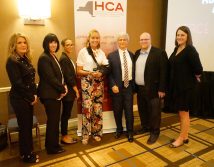Inspired by the state’s DSRIP initiative, People, Inc. of Western New York and its home care agency decided to test a hypothesis: Could they decrease visits to the emergency room (ER) and improve home care by adopting a standardized best-practice model of care paths and triage software?
It turns out, yes.
Over a three-year period, they’ve tested such a model for 950 individuals with intellectual and developmental disabilities, a medically at-risk population.
Under this program, an RN is dispatched to provide an in-home assessment in response to an injury or illness call involving a resident at one of People Inc.’s group homes. Using telemedicine, the RN remotely connects with a physician, who performs a video assessment of the client. Based on this assessment, the RN can perform other state-of-the-art assessments and implement new orders on site.
As a result, avoidable emergency cases are identified and treated more quickly and efficiently, substantially curbing unnecessary ER and urgent care visits.
New York’s DSRIP and Value Based Payment initiatives are all oriented toward a goal of reducing unnecessary hospital use by 25%. The People, Inc. model falls squarely into this metric for an at-risk sub-population that utilizes health care services at a significantly higher rate than the general population.
In its analysis, People, Inc. estimates that it can reduce the number of ER and urgent care visits by 25% at a cost savings of nearly $200,000 annually for this single line of intervention alone.
In recognition of this program, HCA presented People, Inc. with our 2019 ‘Triple Aim Quality and Innovation Award.’ What impressed us most about this program is the great care that went into determining specific protocols and pathways which were aided by technology as a tool to efficiently bridge the combined expertise of a physician and the RN at the point of care.
This is exactly the kind of model that is replicable statewide, with the help of infrastructure and health information technology support that offers enormous promise for providers in the home care field.



